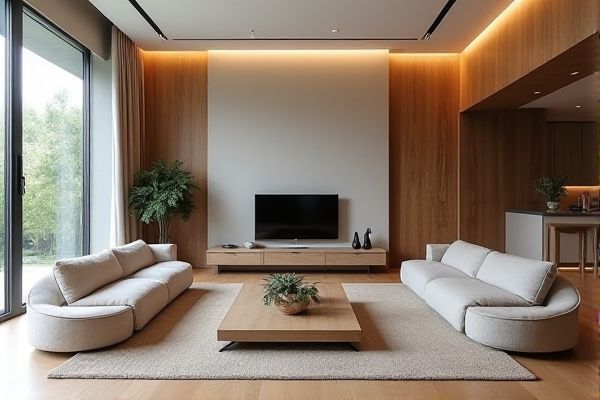
Minimalist design emphasizes simplicity, clean lines, and functionality by using limited color palettes and uncluttered spaces, while maximalist design embraces bold colors, diverse patterns, and layered elements to create visually rich environments. Explore the rest of the article to discover how you can choose the design style that best suits your personality and space.
Table of Comparison
| Aspect | Minimalist Design | Maximalist Design |
|---|---|---|
| Definition | Design focusing on simplicity and essential elements | Design emphasizing abundance and elaborate detail |
| Color Palette | Neutral and limited colors | Bold, vibrant, and diverse colors |
| Space Usage | Ample negative space | Dense with minimal negative space |
| Visual Elements | Clean lines and minimal decoration | Ornate patterns and rich textures |
| Focus | Functionality and clarity | Expression and personality |
| Typography | Simple and legible fonts | Mixed, decorative fonts |
| Target Audience | Professionals valuing clarity and efficiency | Creative users seeking uniqueness and vibrancy |
| Examples | Apple product design, Scandinavian interiors | Bohemian decor, eclectic fashion |
Understanding Minimalist Design: Core Principles
Minimalist design emphasizes simplicity, clean lines, and a focus on essential elements to create uncluttered and functional spaces. It prioritizes negative space, neutral color palettes, and quality over quantity, promoting calmness and clarity in your environment. Understanding these core principles helps you create a balanced design that highlights purpose and form.
Defining Maximalist Design: Key Characteristics
Maximalist design is characterized by bold colors, diverse patterns, and an abundance of decorative elements that create a visually rich and dynamic space. It embraces layering textures, mixing styles, and showcasing personal collections to express individuality and creativity. Your environment transforms into an eclectic, vibrant setting that contrasts sharply with the simplicity of minimalist design.
History and Evolution of Minimalism vs Maximalism
Minimalist design emerged in the early 20th century, influenced by movements like Bauhaus and De Stijl, emphasizing simplicity, functionality, and clean lines to create uncluttered spaces. Maximalist design evolved as a reaction to minimalism, drawing inspiration from Victorian opulence, baroque art, and eclecticism, celebrating bold colors, intricate patterns, and layered textures. Both styles reflect cultural shifts, with minimalism aligning with modernism's focus on efficiency and maximalism embracing individuality and maximal self-expression.
Visual Impact: Simplicity vs Vibrancy
Minimalist design prioritizes clean lines, negative space, and limited color palettes to create a visually calming and focused environment. Maximalist design embraces vibrant colors, diverse textures, and layered elements to generate energetic and dynamic visual interest. The contrast between simplicity and vibrancy shapes the viewer's emotional response and engagement with the space.
Color Palettes: Restricted vs Bold
Minimalist design emphasizes restricted color palettes, often using neutral tones or monochromatic schemes to create clean, calm, and uncluttered spaces. Maximalist design embraces bold color palettes featuring vibrant hues and contrasting patterns, resulting in dynamic and visually stimulating environments. The choice between these approaches significantly influences the mood and perception of space, with minimalism promoting simplicity and maximalism celebrating exuberance.
Space Utilization in Minimalism and Maximalism
Minimalist design maximizes space utilization by emphasizing clean lines, open areas, and functional furniture, creating an uncluttered environment that enhances flow and light. In contrast, maximalist design fills space with layered patterns, vibrant colors, and abundant decor, which showcases personality and creates visual interest but can reduce the perception of spaciousness. Your choice between these styles influences how efficiently your space feels and functions in everyday use.
User Experience: Clarity vs Expression
Minimalist design enhances user experience by prioritizing clarity, reducing visual clutter to help users focus on essential content and functions, which streamlines navigation and decision-making processes. Maximalist design emphasizes expression through rich visuals, textures, and layered elements, creating an immersive and emotionally engaging experience that can resonate with users seeking creativity and individuality. Both approaches impact usability differently, with minimalist favoring simplicity and efficiency, while maximalist promotes personality and detailed exploration.
Popular Applications in Interior and Graphic Design
Minimalist design, characterized by clean lines, neutral colors, and simplicity, is widely applied in modern interior spaces and digital interfaces to create a sense of calm and clarity. Maximalist design embraces bold patterns, vibrant colors, and eclectic details, often used in interior decor for expressive living rooms and in graphic design to capture attention with layered visuals. Popular applications include minimalist Scandinavian interiors and sleek website layouts versus maximalist bohemian rooms and intricate poster designs.
Choosing the Right Style for Your Project
Minimalist design emphasizes simplicity, clean lines, and a restrained color palette to create a calm, uncluttered space that enhances functionality. Maximalist design embraces bold colors, intricate patterns, and a rich layering of textures and decor, making your project vibrant and personalized. Your choice between these styles should align with the project's purpose, audience, and desired emotional impact to ensure a cohesive and effective design outcome.
Future Trends: The Shift Between Minimalism and Maximalism
Future trends indicate a dynamic shift between minimalist and maximalist design, driven by evolving consumer preferences and technological advancements. Minimalism emphasizes simplicity, clean lines, and functional spaces, appealing to those seeking calm and clarity in their environments. Maximalism, characterized by bold colors, layered textures, and eclectic decor, caters to audiences craving personalized, visually stimulating interiors, giving Your design choices flexibility to adapt to either aesthetic based on emerging lifestyle trends.
 homyna.com
homyna.com